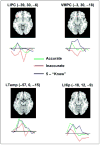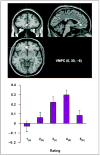The role of VMPC in metamemorial judgments of content retrievability
- PMID: 15904549
- PMCID: PMC1193651
- DOI: 10.1162/0898929053747694
The role of VMPC in metamemorial judgments of content retrievability
Abstract
Making judgments about the retrievability of information is a critical part of the metamemory processes engaged during remembering. A recent study of patients with frontal lesions suggests that ventral medial prefrontal cortex (VMPC) plays a critical role in such judgments [Schnyer, D. M., Verfaellie, M., Alexander, M. P., Lafleche, G., Nicholls, L., & Kaszniak, A. W. A role for right medial prefrontal cortex in accurate feeling of knowing judgments: Evidence from patients with lesions to frontal cortex. Neuropsychologia, 42, 957-966, 2004]. The observed impairment was thought to reflect an inability to determine the accessibility of memory contents. To further examine the neuroanatomical basis of content accessibility assessment, we used fMRI in an episodic feeling-of-knowing (FOK) paradigm. Participants were asked to make trial-by-trial predictions about the retrievability of the final word that completed studied sentences and then to select the correct completion from among alternatives. Results indicated that the VMPC is engaged during accurate FOK judgments and its activation is modulated by retrieval rating. Structural equations modeling supported the notion that VMPC, as part of a broader left hemisphere network involved in memory retrieval, monitors the output of the retrieval process. More generally, VMPC may participate in metacognitive processes that allow for the comparison of available data against an internal model.
Figures





References
-
- Akaike, H. (1973). Information theory and an extension of the maximum likelihood principle. In B. N. Petrov & F. Csaki (Eds.), Proceedings of the 2nd international symposium on information theory (pp. 267–281). Budapest: Akademiai Kiado.
-
- Becker S, Lim J. A computational model of prefrontal control in free recall: Strategic memory use in the California Verbal Learning Task. Journal of Cognitive Neuroscience. 2003;15:821–832. - PubMed
-
- Bentler PM. Comparative fit indexes in structural models. Psychological Bulletin. 1990;107:238–246. - PubMed
-
- Bloom PA, Fischler I. “Completion norms for 329 sentence contexts”. Memory and Cognition. 1980;8:631–642. - PubMed
-
- Brett, M., Nichols, T., Andersson, J., Wager, T., & Poline, J.-B. (2004). When is a conjunction not a conjunction? Paper presented at the Annual Meeting of the Organization of Human Brain Mapping, Budapest.
Publication types
MeSH terms
Grants and funding
LinkOut - more resources
Full Text Sources

